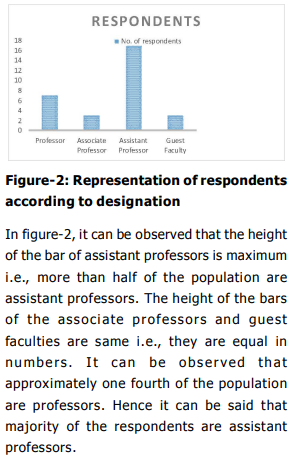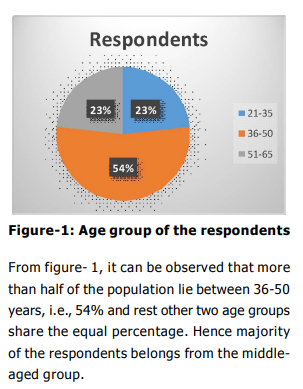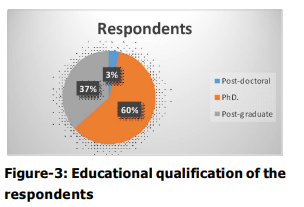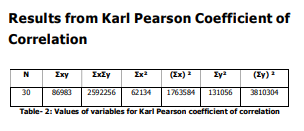Indian Journal of Health Social Work
(UGC Care List Journal)
Stress and Burnout among Working Women: A Study of Female Faculty Members of Visva-Bharati University West Bengal
Shaurya Prakash1, Subhashree Sanyal2 & Kheyali Roy3
1,3Assistant Professor, Gopal Narayan Singh University, Bihar and Research Scholar, Department of Social Work, Visva-Bharati, Sriniketan, West Bengal, 2 Assistant Professor, Department of Social Work, Visva-Bharati, Sriniketan, West Bengal
Correspondence: Shaurya Prakash, e-mail id: sauryap75@gmail.com
ABSTRACT
Background: Stress is a common phenomenon observed in everyone’s life. Occupational stress has become one of the main factors in reducing efficiency and loss of human resources that may cause physical and psychological adverse effects among employees. These job-related stress leads to the burnout to the female faculties. Burnout is the product of long-term stress in the workplace (Park, 2015). Aim: To explore the level of stress and burnout, various stressors and coping strategies adhered by the faculty members. Methods and materials: The study followed a mixed methodology (Eclectic Design). The research design of the study is descriptive and it is qualitative and quantitative research. The researchers have adopted questionnaire as the tools of data collection. In order to find out the causes of the stress and coping strategies adhered by the female faculties case study is taken into consideration. Results: The majority of the respondents are under moderate amount of stress and have a fair chance of burning out. concluded that age and stress are weakly related variables with a positive relation. The present paper speaks of burnout among faculties of University. Results bring to light various causes of stressors and the possible linkages between them. Conclusion: Thus it can be concluded that this paper will help the readers to explore various stressors and its coping strategies adhered by female faculty members.
Keywords: Stress, Burnout, Women, Occupational Stress, University.
INTRODUCTION
Stress is the psychological strain or distress resulting from exposure to unusual or demanding situations, known as stressors. Occupational stress (OS), specifically, is the response to organizational stressors in the workplace environment that pose “a perceived threat to an individual’s well-being or safety”. In addition to organizational factors, individual level factors have also been implicated in stress outcomes, both as contributing factors as well as moderators of stress (Cullen, 1985). Long term stress can lead to burnout which is conceptualized as a “psychological syndrome in response to chronic interpersonal stressors on the job” which arises due to an imbalance between the demands placed on individuals and their ability to cope. This syndrome is characterized by feelings of exhaustion, cynic ism, detachment, ineffectiveness and a personal lack of accomplishment. (Maslach, Schaufeli, Leiter, 2001).
According to Fred Luthans (1998), stress is the adaptive response to the external situation that results in deviation for organizational participants. The factors which contribute to the stress are called stressors. According to Don Hellriegel (2001), individual’s experience of stress depends on the following factors: – (i) the person’s perception of the situation, (ii) the person’s past experience, (iii) the presence or absence of social support, and (iv) individual differences with regard to stress reactions. Stress can be both positive as well as negative. Those stressors which provide an opportunity to gain something are said to be as positive stress. Eustress is the term used for the positive stress. And those stress which leads to any disturbances in individual’s life are said to be negative stress. Distress is the term used for negative stress.
Occupational stress is treated as a state of tension which occurs when a person senses a disagreement be tween the working environment challenges and their possibilities of coping. A moderate amount of occupational stress could be motivating and impelling, but the situation becomes serious if the stress is too high or long-term and there are little coping resources. This is a neurochemical process which, for example, increases the heartbeat rate, quickens the breathing and sharpens the way the person senses their surroundings. These are important reactions in a situation with only two choices of coping – fighting or flighting. Adaption, which has proven to be useful before, does not justify itself in the case of long-term stress, so common in cont emporary wo rki ng environment – the body tires, mental and physical health disorders appear.
Stress sensed in life is not, in general, limited only to the workplace and drawing the line between occupational and personal life tensions is often complicated or even impossible. Illness of a family member, children are going to school or a breakup probably influences the employee’s capability to work. Even though such circumstances are out of the employer’s responsibility for the employee’s health, a good employer could consider supporting the employee in such circumstances, thereby preventing the likely transition of problems into the working life. (Quick & Henderson, 2016)
Working women (WW) earning wages or salary are part of a modern phenomenon, one that developed at the same time as the growth of paid employment for men, but women have been challenged by inequality in the workforce. Women who are involved in the workforce and get wages or salary are referred as working women. Thomson Reuter‘s Foundation, with support from the Rockefeller Foundation, embarked on the global task, asking more than 9,500 women at work in the advanced economies of the G20 for the issues that affect them most at work. The findings of the task are compelling – Worklife balance, Equal pay, Harassment, Career opportunities, Children and career. The global report shows that four in every ten women see the gender pay gap as a key issue, with women in seven nations listing the discrepancy as their majo r concern. (Corporate Responsibility & Inclusion Report, Thomas Reuters Foundation, 2015).
Working Women in India India has given equal opportunity to both men and women in order to avail equal rights and services. Nearly 38 percent of women reported experiencing physical violence at least once in their married life, while 72 percent encounter psychological abuse.
After globalization, women are bagging more and more job opportunities. India is the first among countries to give women equal 3 0 Stress and Burnout among Working Women: A Study of Female Faculty Members of Visva-Bharati University West Bengal Indian Journal of Health Social Work. 4(1) January-June, 2022 franchise and has a high credible record with regards to the enactment of laws to protect and promote the interest of women. But women continued to be denied economic, social and legal rights and privileges. Women plow fields and harvest crops while working on farms, women weave and make handicrafts while working in the household industries, they sell food and gather wood while working in the informal sector making mo ney for them and their family. (Swaminathan, S. A. Aiyar, 2016). The cultural restrictions were the primary obstacles to female employment, now however, with the shortage of jobs in every sector even lead to more unemployed women in the country. Even if the women are employed, she may not have control over the money she earns, though this money often plays an important role in the maintenance of the household. In Indian culture women are expected to devote virtually all of their time, energy and money to their family. The basic infrastructure of society has hardly improved, though the role of women within the same structure is passing through a transitional phase. It is but natural that she would remain vulnerable to exploitation even in her economicall y independent state. (Dheera Likhi, 2009) Challenges Faced by Working Women in India Jyotsna Gandhi (2014), in her paper titled, “Challenges faced by working women in India” tried to explain the challenges by Indian working women. India is the only country where women are seen as resemblance of goddess but the conditions and situations of Indian women have been worsened rather getting better. Indian Working Women do face in their day-to-day life which certainly makes their jobs/works more arduous for them. These are some of the issues which actually demotivate women to work and contribute to their family. Now the time has come to change the mindset. The Laws should be practiced strictly which provide total security, equal remuneration and a safe working atmosphere for the working women. There is a deliberate need to reshuffle the mindsets and beliefs of the family members, employers, colleagues and the public at large. (Gandhi, 2014).
Burnout is not simply a result of long hours. The cynicism, depression, and lethargy of burnout can occur when a person is not in control of how the job is being carried out. Burnout is persistent physical, mental or emotional exhaustion caused by long-term stress, usually as a result of excessive workplace and/or personal responsibilities. Because burnout cannot coexist with engagement, it’s a serious problem for the enterprise. Burnout is associated with higher stress levels, poorer performance, more illnesses and absenteeism, and less productivity. In a corporate culture that places high demands on employees, the cumulative effect can be lower profitability and higher staff turnover. The concept of burnout comes from psychology. Herbert Freudenberger, a clinical psychologist, first identified the concept in the 1970s. Social psychologists Christina Maslach and Susan Jackson subsequentl y developed an assessment tool, the Maslach Burnout Inventory that characterizes burnout as a syndrome involving exhaustion, cynicism, and inefficacy. The predominant characteristic of burnout is often considered to be exhaustion. (Gupta M, 2019).
Burnout is not considered a separate disorder because it overlaps significantly with depression. A recent study by Bianchi, Schonfeld, and Laurent found that 90 percent of workers identified as burned out also met diagnostic criteria for depression. Depending on the particular case, burnout may be alleviated by changes in the work environment and job demands, as well as changes in the individual’s behavior and approach to work. If nothing changes, however, burnout tends to create a downward spiral, in which an unsustainable situation leads to exhaustion and dissatisfaction, which lead to poorer performance, which in turn leads to a worsened work situation or even job loss and increased stress on the individual. (Renzo Bianchi, Ervin Sam Sconfeld & Eric Laurent, 2014).
Occupational stress is the major work place hazard in present day working environment. It is the indispensable and imperative element needed to be channelized for the benefits of employees and organization.
It is o bserved tha t female generally experience higher levels of occupational stress to burnout compared to men and their personal success perceptions are lower. The ratio of working women in service sector is increasing as a constant phase. The changes in culture of work and hierarchy are also reasons for changes obtained in the source of facing occupational stress and its influence on burnout. The present study attempted to fill the gap of exploring the evidences for occupational stress to burnout among working women. The study has made an initial attempt of choosing a university in India, Visva-Bharati to view the outcome of burnout among the working women & that will become the base for further studies since burnout has become an unavoidable element needed to be studied at work places.
The study followed a mixed methodology (Eclectic Design). In the present study the researchers have formulated the rationale of the study in which he needs to find the way through which the female faculty members can eliminate their level of stress and burnout which leads to a healthy and stress-free life.
- H0 = Designation of the female faculty members has no influence on the stress level.
- H1 = Designation of the female faculty members has influence on the stress level.
- H0 = Age group of the female faculty members has no influence on the stress level.
- H1 = Age group of the female faculty members has influence on the stress level.
The researchers have tried to interpret all the information collected during the research through statistical representation, graphs, pie charts etc. which will further help researchers to analyze the data to have deta il understanding of the findings. This section helps to understand the level of the stress, causes of the stress and various coping techniques of the stress experienced by the female faculty members of Visva-Bharati (VB)
In this section the researchers have explained the age, gender, designation and educational qualification of the female faculty members in Visva-Bharati. This section actually deals with the quantitative finding of the research.
The primary data collected by the researchers helps to find out various statistical data which are as follows:


 Fi gure- 3, describ es the educational
qualification of the female faculty members
in Visva-Bharati. It can be easily observed that
the entire population comprises of three
different level of educational qualification, i.e.,
Post-doctoral, Ph.D. and Post-graduation.
From the data it can illustrated that majority
of the population have Ph.D. as their
educational qualification, i.e., 60% of the
entire sample, more than one third of the
population are post graduate, i.e.,36.66% of
the entire population and only one female faculty member has post-doctoral educational
qualification.
Fi gure- 3, describ es the educational
qualification of the female faculty members
in Visva-Bharati. It can be easily observed that
the entire population comprises of three
different level of educational qualification, i.e.,
Post-doctoral, Ph.D. and Post-graduation.
From the data it can illustrated that majority
of the population have Ph.D. as their
educational qualification, i.e., 60% of the
entire sample, more than one third of the
population are post graduate, i.e.,36.66% of
the entire population and only one female faculty member has post-doctoral educational
qualification.
Thus, it can be concluded that the entire population covered in the research is highly educated.
Stress Level in Female Faculty Members
The average stress experienced by the female faculty members in Visva-Bharati is 65.06 which means the job-rel ated stres s experienced by the female faculty members of Visva-Bharati is moderate and have a fair chance of burning out.
 In figure- 4, it can be observed that the
respondent 20 experiences highest degree of
stress i.e., 85 whereas respondent 4
experiences lowest degree of stress i.e., 42
on the basis of scoring method as developed
by the researcher. In figure: 9, the stress
experienced by ea ch respondent are
represented on the line graph. The maximum
level of stress experienced is 85 by respondent
20 which means the respondent 20 express a
high amount of job-related stress and have
begun to burnout. And respondent 4
experiences lowest stress, i.e., 42 which
means she expresses low amount of jobrelated stress and are not likely to burnout.
Thus, it can be said that the respondent 20
experiences highest degree of stress i.e., 85 whereas respondent 4 experiences lowest
degree of stress i.e., 42 on the basis of scoring
method as developed by the researcher.
In figure- 4, it can be observed that the
respondent 20 experiences highest degree of
stress i.e., 85 whereas respondent 4
experiences lowest degree of stress i.e., 42
on the basis of scoring method as developed
by the researcher. In figure: 9, the stress
experienced by ea ch respondent are
represented on the line graph. The maximum
level of stress experienced is 85 by respondent
20 which means the respondent 20 express a
high amount of job-related stress and have
begun to burnout. And respondent 4
experiences lowest stress, i.e., 42 which
means she expresses low amount of jobrelated stress and are not likely to burnout.
Thus, it can be said that the respondent 20
experiences highest degree of stress i.e., 85 whereas respondent 4 experiences lowest
degree of stress i.e., 42 on the basis of scoring
method as developed by the researcher.  From table- 1, it can be said that more than half of the respondents i.e., 53.33% lie between 51-70 score which indicates that they are under moderate amount of stress and have a fair chance of burning out, 30% of the respondents are having score between 71-90 which indicates that they are under high amount of job-related stress and have begun to burnout. They need stress reduction and burnout prevention and rest of are having score between 41-50 which indicates that they express a low amount of job-related stress and are not likely to burnout.
From table- 1, it can be said that more than half of the respondents i.e., 53.33% lie between 51-70 score which indicates that they are under moderate amount of stress and have a fair chance of burning out, 30% of the respondents are having score between 71-90 which indicates that they are under high amount of job-related stress and have begun to burnout. They need stress reduction and burnout prevention and rest of are having score between 41-50 which indicates that they express a low amount of job-related stress and are not likely to burnout.
 From figure- 5: Stress level of associate professors > Stress level of professors > Overall stress > Stress level of guest faculties > Stress level of assistant professors.
From figure- 5: Stress level of associate professors > Stress level of professors > Overall stress > Stress level of guest faculties > Stress level of assistant professors.
Hence it can be concluded that stress level experienced by professors and associate professors is more than the overall average stress experienced by the female faculty members. The stress experienced by the associate professors is highest and the stress experienced by the assistant professors is lowest.
 The correlation coefficient can be interpreted by observing its sign and magnitude. Since r is positive, i.e., >0, it can be concluded that age and level of stress are positively related variables, i.e., as age increases there is possibility of getting higher stress. Observing the magnitude, it can be concluded that the correlation exercised between age and stress level is highly weak.
The correlation coefficient can be interpreted by observing its sign and magnitude. Since r is positive, i.e., >0, it can be concluded that age and level of stress are positively related variables, i.e., as age increases there is possibility of getting higher stress. Observing the magnitude, it can be concluded that the correlation exercised between age and stress level is highly weak.
- H0 = Designation of the female faculty members has no influence on the stress level.
- H1 = Designation of the female faculty members has influence on the stress level.
![]()
-
- H0 = Age group of the female faculty members has no influence on the stress level.
- H1 = Age group of the female faculty members has influence on the stress level.
- H0 = Age group of the female faculty members has no influence on the stress level.
- H1 = Age group of the female faculty members has influence on the stress level.

Stress in the workplace has become one of the most triggering concepts these days which is actually creating disturbances in the individual’s life. The concept of stress at workplace has emerged immensely in the last decade. It has become a major concern among various organizations creating an impact on the management and operations of the organization. In order to overcome the stressful events, the particular individual must adopt some coping strategies so that the work-life balance must be maintained. In this section the researcher has focused on the causes and coping strategies adhered by the female faculty members.
In this study there are various causes of stress which disturbs the female faculty members to manage their job and personal life. The researcher‘s findings contain the factors which contribute to the stressful events in the life of female faculty members in VisvaBharati. The stressors which cause stress to the female faculty members are: most of the female faculty members think that the student‘s approach toward their study disturbs them the most. They think that students are not studying properly which enables their stressors. They need to spend a lot of time in the same repetitive events to help the students to get good grades, many female faculties blame technology as one of the mos t important stressors in their life. Due to advancement in technology the students are less keen attend classes and learn. The concept of books and copies has almost vanished. Today‘s students are more focused on internet learning websites instead of classroom learning, as many female faculty members belongs to other place i.e., native place which makes them to stay away from their relatives and friends. Living far from their native places also contributes to the stress in their life, in many cases the researcher observed that infrastructure also plays an important role in the stressful life. Due to old infrastructure female faculty members are getting difficulties in their workplace which increases their stress, during examination period they encounters a lot of stressful events such as setting of question papers, invigilation, checking of answer papers which enhances the level of stress in their life, many non-academic activities, i.e., seminars , workshops, excursion, faculty development programs etc. also increase the stress , unclean toilets and washrooms, absence of proper drinking water facility also contributes to the stress for the female faculty members in Visva-Bharati, most of the female faculty members also said that student‘s behaviors disturb them a lot, more work to the department also increases the stress level of female faculty members, sound of machines during construction work, some of the faculty members think that being overweight is the most stressful thing in the life. It actually disturbs the balance of life, some of the female faculty members thinks that a lot of parallel work causes more stress, most of the female faculty members thinks that their job is full of too many repetitive situations which increases their stress level, many faculty members lack supports from their co-workers which is another most important factor which increases their stress level.
In the present study the researchers find different types of coping techniques adopted by the female faculty members. But interesting fact is that almost most female faculty members adopted same thing as their coping strategies.
While some workplace stress is normal, excessive stress can interfere with your productivity and performance, impact your physical and emotional health, and affect your relationships and home life. It can even determine success or failure on the job. You can’t control every thing in your work environment, but that doesn’t mean you’re powerless, even when you’re stuck in a difficult situation. Whatever your ambitions or work demands, there are steps you can take to protect yourself from the damaging effects of stress, improve your job satisfaction, and bolster your well-being in and out of the workplace.
Occupational stress is one of the mos t concerned factors these days. This paper is an attempt to explore the occupational stress and burnout among working women. It also helps to explore the various stressors related to occupation. The research intends to highlight the level of stress, causes of stress and coping strategies adopted by the female faculty members in order to have a stressfree life.
Role of funding source: None

ISSN: 2582-1393 (online)
UGC Care List Journal

